Raphael and His Circle
NATIONAL GALLERY OF ART, Washington
February 16 through June 14, 2020
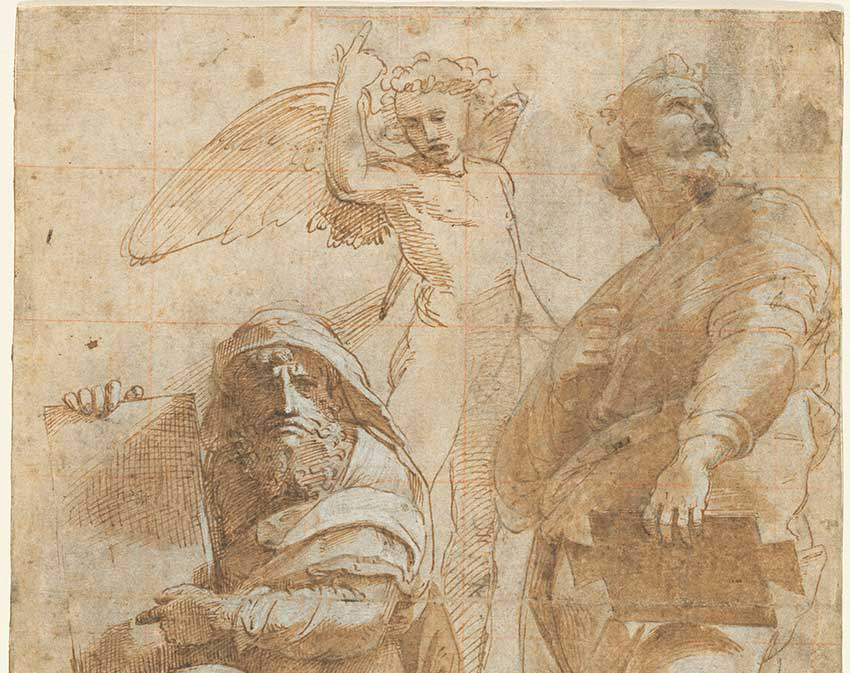 Raphael, Details of The Prophets Hosea and Jonah, c. 1510,
Raphael, Details of The Prophets Hosea and Jonah, c. 1510,
Raphael and His Circle features 26 prints and drawings
by Raphael’s collaborators and followers,
and by printmakers who were inspired by him.
The exhibition shows from the Gallery’s collection, the complexity, range, and immediate influence of his style as it become the standard for aesthetic excellence in Western art.
RAFFAELLO SANZIO,
called RAPHAEL
Urbino, 1483 – Rome, 1520
Raphael is recognized by many as the first and foremost figure of the classical tradition in Western painting. His art, featuring balanced compositions and idealized beauty, epitomizes the Italian Renaissance and was tremendously influential in his lifetime and after. Born Raffaello Sanzio in 1483 in Urbino, Italy, Raphael moved to Florence at age twenty-one, and from 1508 on he worked in Rome.
There he became the preferred artist of the city’s leading patrons, including successive popes Julius II and Leo X, who commissioned Raphael to create frescoes and other works for the Vatican. During his later years in Rome, Raphael broadened his activity to create designs for other media, such as tapestries and prints.
Eight Apostles
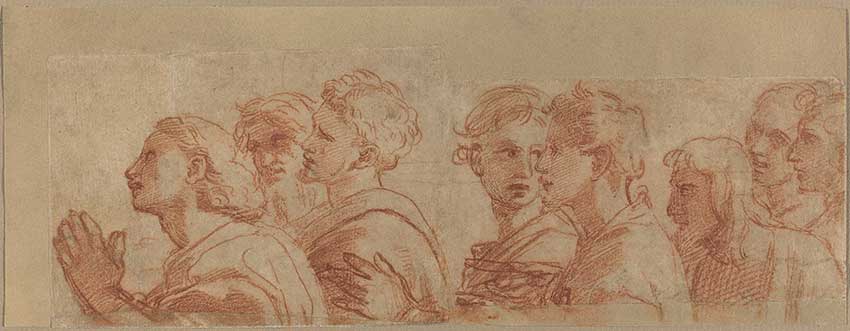 Raphael, Eight Apostles, c. 1514, red chalk over stylus underdrawing and traces of leadpoint on laid paper, cut in two pieces and rejoined; laid down. sheet: 8.1 x 23.2 cm (3 3/16 x 9 1/8 in.) support: 9.4 x 24.8 cm (3 11/16 x 9 3/4 in.) National Gallery of Art, Washington, Woodner Collection
Raphael, Eight Apostles, c. 1514, red chalk over stylus underdrawing and traces of leadpoint on laid paper, cut in two pieces and rejoined; laid down. sheet: 8.1 x 23.2 cm (3 3/16 x 9 1/8 in.) support: 9.4 x 24.8 cm (3 11/16 x 9 3/4 in.) National Gallery of Art, Washington, Woodner Collection
This is a study for the group of apostles in Raphael’s Christ’s Charge to Saint Peter, one of his designs for a set of ten tapestries to decorate the lower walls of the Sistine Chapel. The drawing is a fragment — in fact, two joined fragments — from a larger study for the full composition.
Nevertheless it conveys the monumental forms, spatial relationships between the figures, and expressions that characterize the artist’s mature style. From this stage onward, Raphael favored chalk over pen and ink for exploring the tonal properties of a design in preliminary studies.
RAPHAEL
Saint George and the Dragon
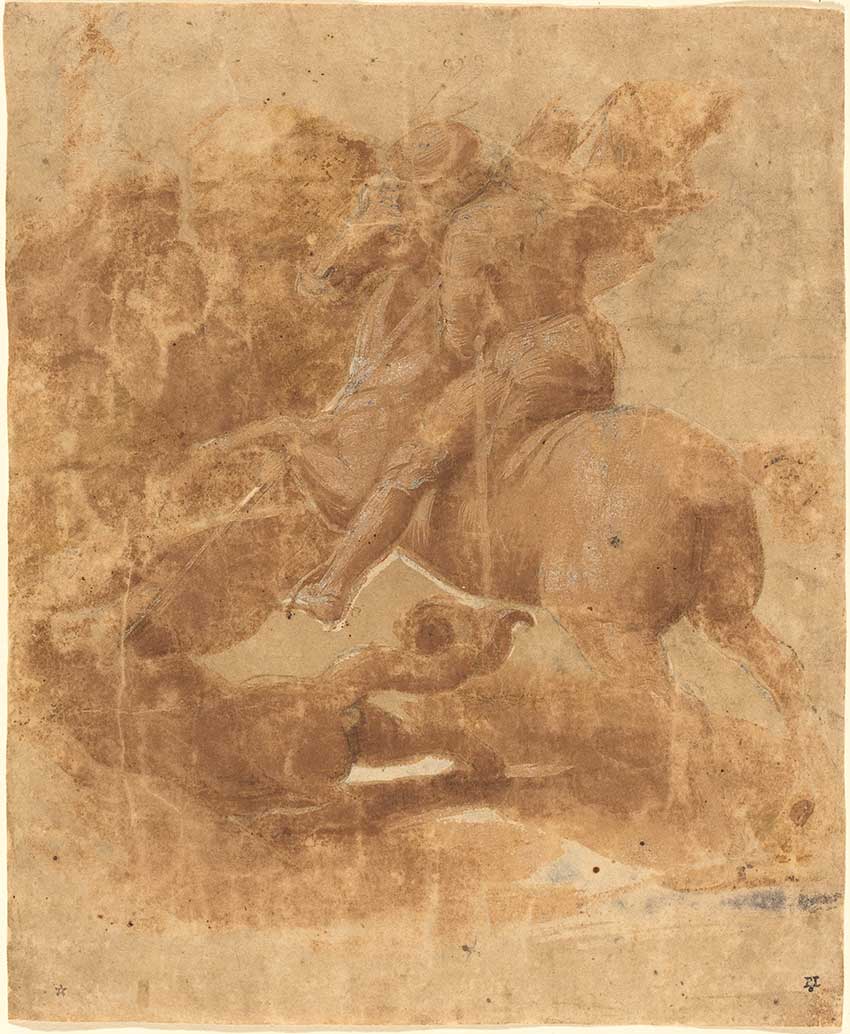 Raphael, Saint George and the Dragon, c. 1506, brush and brown ink heightened with white over black chalk, incised with stylus, overall (approximate): 24.5 x 20.3 cm (9 5/8 x 8 in.) National Gallery of Art, Washington, Ailsa Mellon Bruce Fund
Raphael, Saint George and the Dragon, c. 1506, brush and brown ink heightened with white over black chalk, incised with stylus, overall (approximate): 24.5 x 20.3 cm (9 5/8 x 8 in.) National Gallery of Art, Washington, Ailsa Mellon Bruce Fund
This is one of two final studies for the painting of the same subject in the Gallery’s collection (on view in gallery 20). Raphael has used subtly modulated wash and touches of white to determine the fall of light and shadow and render the volumes of the figures.
The other study, in the Gallerie degli Uffizi in Florence, developed the exact lines and details of the composition. The Gallery’s drawing probably came first, with its contours indented to transfer the outline of the design to the Uffizi’s sheet, where the composition was elaborated and then transferred to the painting’s wood panel. Together they give a sense of Raphael’s meticulous process. (left) Raphael, Saint George.
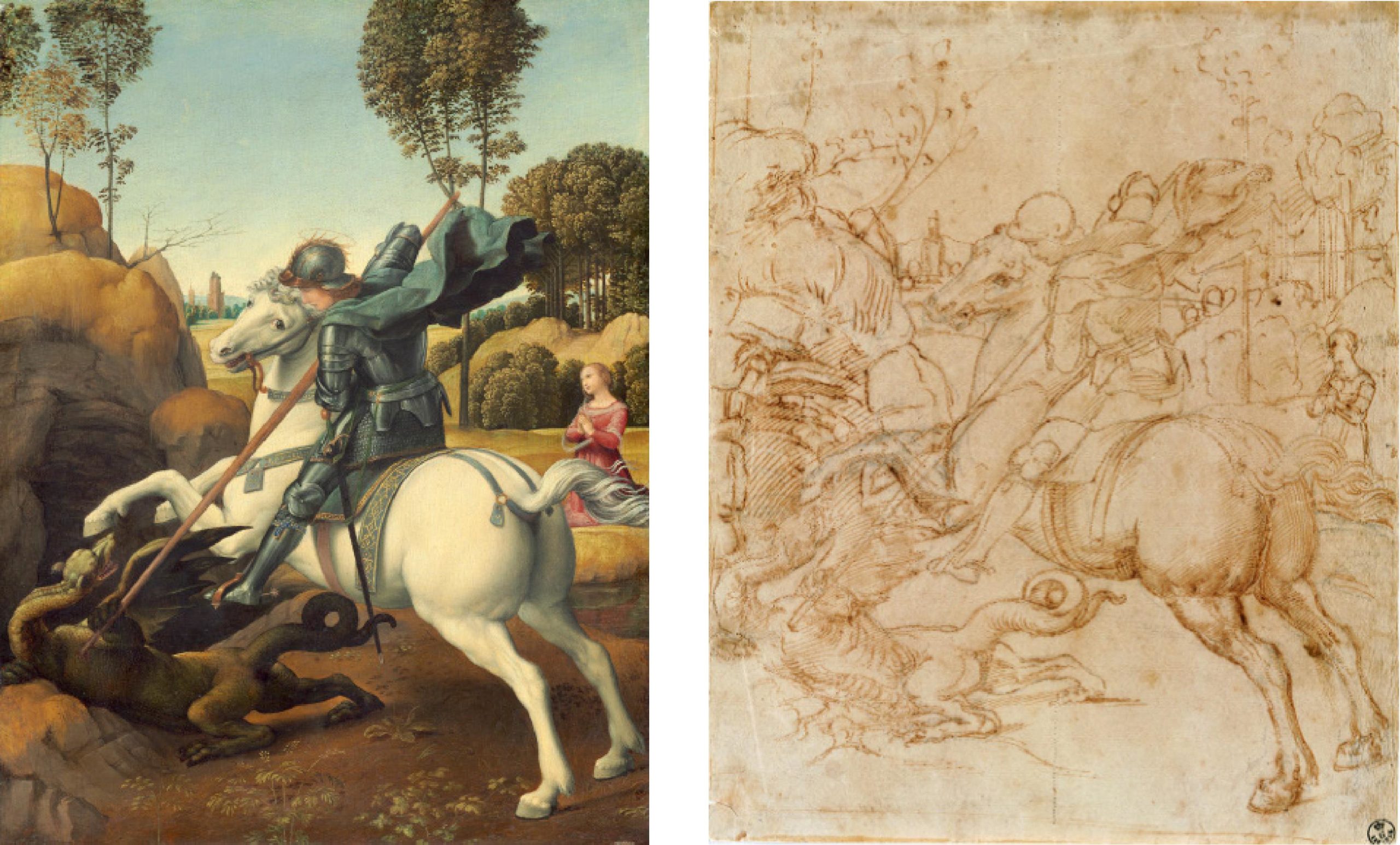 LEFT: Raphael, Saint George and the Dragon, c. 1506, oil on panel, National Gallery of Art, Washington, Andrew W. Mellon Collection, 1937.1.26.
LEFT: Raphael, Saint George and the Dragon, c. 1506, oil on panel, National Gallery of Art, Washington, Andrew W. Mellon Collection, 1937.1.26.
RIGHT: Raphael, Saint George and the Dragon, c. 1506, pen and ink over black chalk, Gabinetto dei Disegni e delle Stampe, Gallerie degli Uffizi, Florence. Photo: Scala/Art Resource, NY
RAPHAEL
The Madonna and Child with Saint John the Baptist
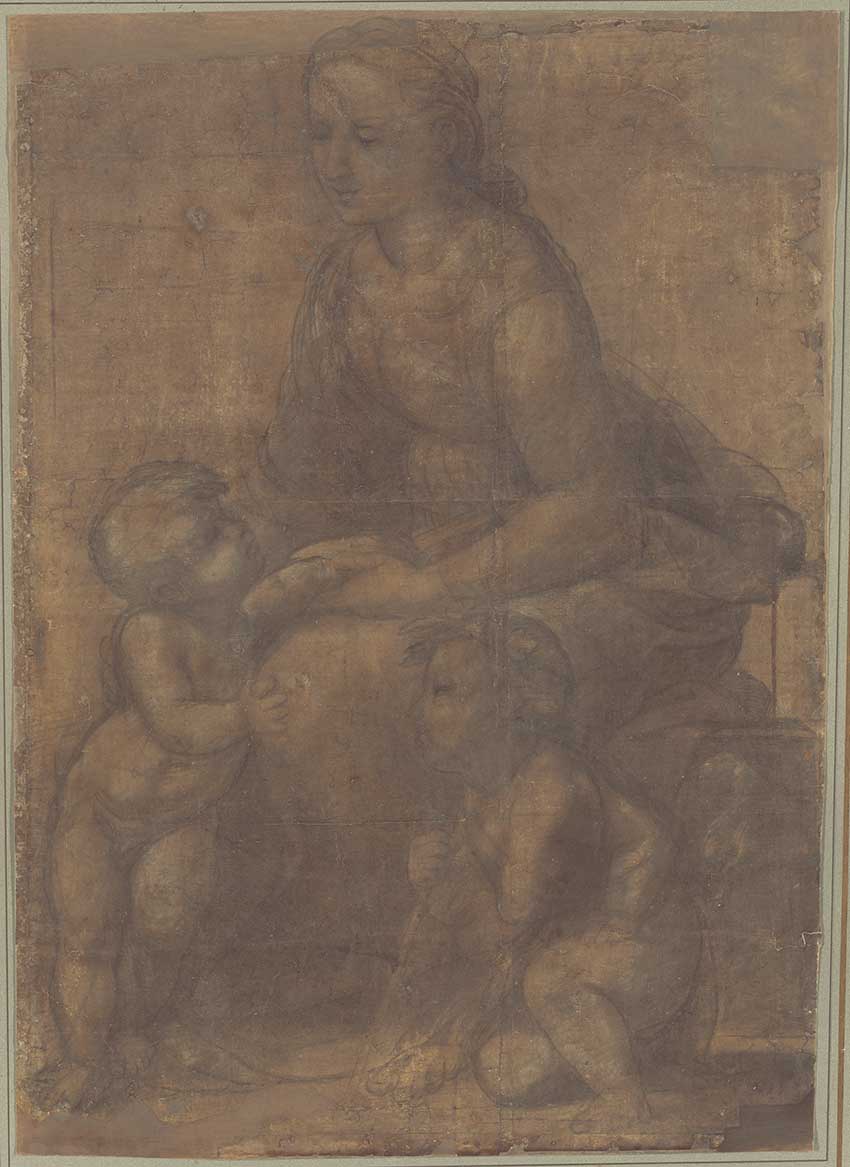 Raphael, The Madonna and Child with Saint John the Baptist, c. 1507, black chalk with traces of white chalk, outlines pricked for transfer; laid down, overall (approximate): 93.8 x 67 cm (36 15/16 x 26 3/8 in.) framed: 138.8 x 112.4 x 12.1 cm (54 5/8 x 44 1/4 x 4 3/4 in.) National Gallery of Art, Washington, Purchased with funds from The Armand Hammer Foundation.
Raphael, The Madonna and Child with Saint John the Baptist, c. 1507, black chalk with traces of white chalk, outlines pricked for transfer; laid down, overall (approximate): 93.8 x 67 cm (36 15/16 x 26 3/8 in.) framed: 138.8 x 112.4 x 12.1 cm (54 5/8 x 44 1/4 x 4 3/4 in.) National Gallery of Art, Washington, Purchased with funds from The Armand Hammer Foundation.
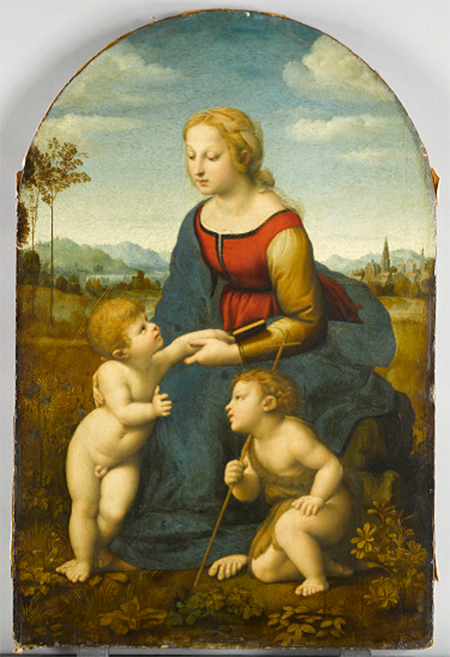 This is the final rendering, or cartoon, from which Raphael prepared one of his most celebrated paintings, the so-called La Belle Jardinière (The Beautiful Gardener), referring to both the Virgin and the painting’s lovely natural setting.
This is the final rendering, or cartoon, from which Raphael prepared one of his most celebrated paintings, the so-called La Belle Jardinière (The Beautiful Gardener), referring to both the Virgin and the painting’s lovely natural setting.
Having developed the composition in a series of drawings, the artist enlarged it to full scale on these joined sheets of paper, pricked the contours with a pin — the tiny holes are barely discernible — and dusted these with powdered black chalk, thus transferring the design to canvas.
Most cartoons were badly damaged during this process, and few survive. This one has darkened because of successive layers of varnish.
Raphael, The Virgin and Child with Saint John the Baptist (La Belle Jardinière), 1507, oil on canvas, Musée du Louvre, Paris. © RMN-Grand Palais/photo: Franck Raux/Art Resource, NY
RAPHAEL
The Prophets Hosea and Jonah
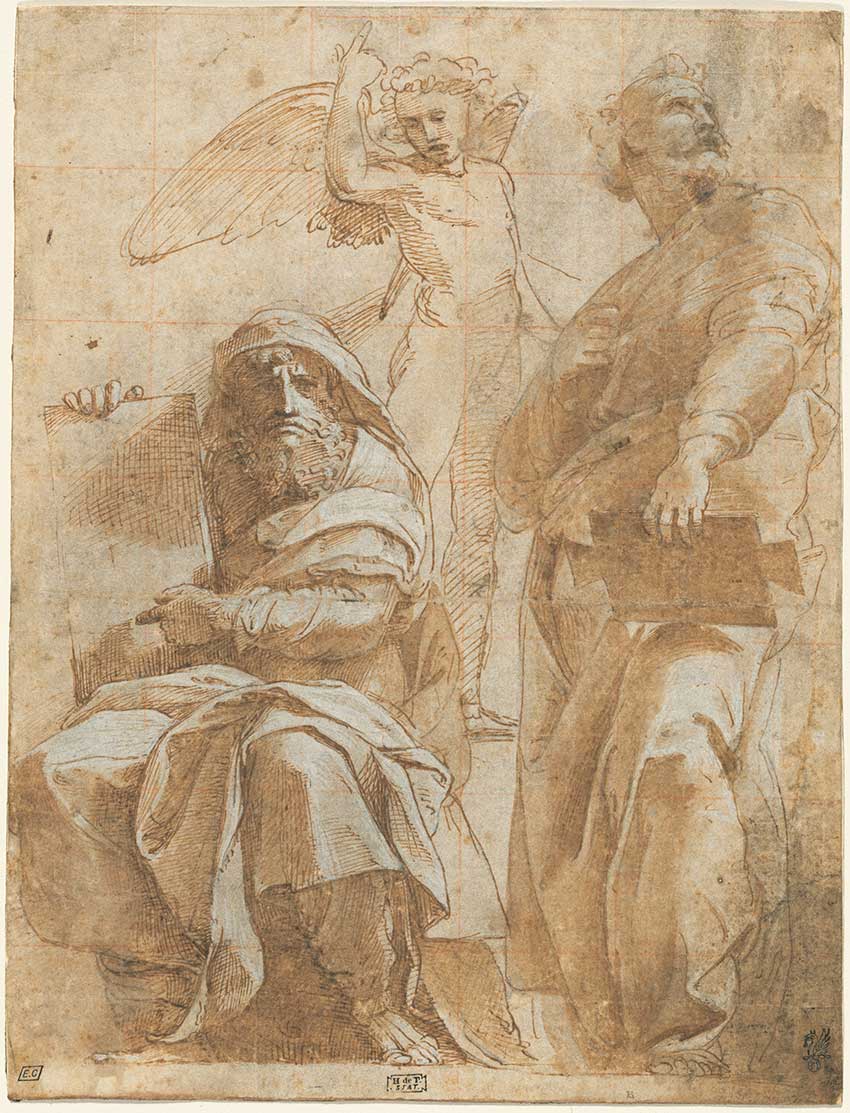 Raphael, The Prophets Hosea and Jonah, c. 1510, pen and brown ink with brown wash over charcoal and blind stylus, heightened with white gouache and squared for transfer with blind stylus and red chalk, on laid paper, overall: 26.2 x 20 cm (10 5/16 x 7 7/8 in.) National Gallery of Art, Washington, The Armand Hammer Collection
Raphael, The Prophets Hosea and Jonah, c. 1510, pen and brown ink with brown wash over charcoal and blind stylus, heightened with white gouache and squared for transfer with blind stylus and red chalk, on laid paper, overall: 26.2 x 20 cm (10 5/16 x 7 7/8 in.) National Gallery of Art, Washington, The Armand Hammer Collection
In 1508 Pope Julius II commissioned Raphael to create frescoes on the walls of the Vatican apartments. While working on these nowcelebrated rooms, Raphael received a commission from his leading private patron, Agostino Chigi, to decorate his family’s chapel in the church of Santa Maria della Pace in central Rome. Both the subject — prophets and sibyls — and the powerful style were responses to Michelangelo’s contemporary work in the Sistine Chapel.
This preparatory study shows part of the decoration to one side of a second-story window. This drawing, with its carefully developed figures and grid for design transfer, would have been used to create the cartoon — the detailed, full-scale model used as a final template for the fresco itself.
PIETRO VANNUCCI,
called PERUGINO
Città della Pieve (Perugia), c. 1450 –
Fontignano (Perugia), 1523
The Adoration of the Shepherds
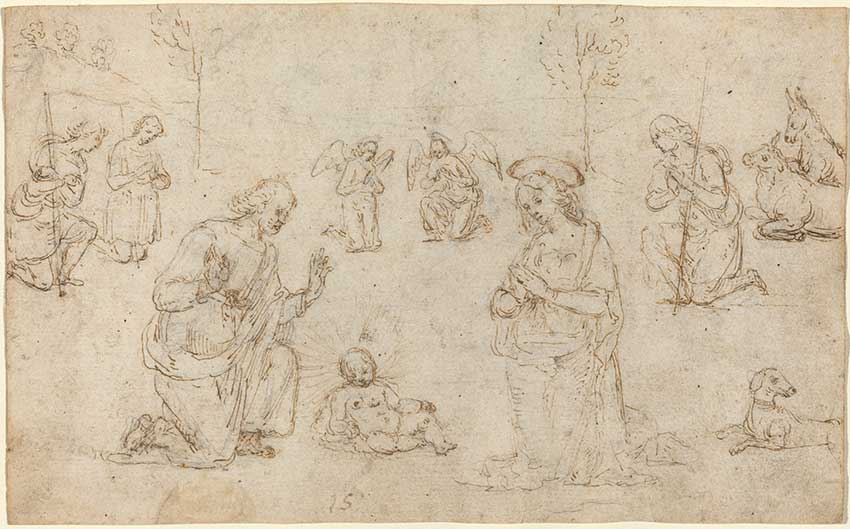
Pietro Perugino, The Adoration of the Shepherds, c. 1517, pen and brown ink over black chalk on laid paper, overall: 13.3 x 21.6 cm (5 1/4 x 8 1/2 in.) National Gallery of Art, Washington, Anonymous Gift
Raphael studied first with his father and later with Perugino, whose art anticipated the regularity and composure of his pupil’s style. Symmetrical and quiet scenes of the Nativity, repeated with slight variation numerous times, were practically Perugino’s trademark.
This particular arrangement with the pair of angels in the background corresponds to a small secondary panel of an altarpiece that depicts the Transfiguration (today in the Galleria Nazionale dell’Umbria). Because of the tentative drawing and certain summary details (the shepherds on the left), it is not clear whether the drawing is a preparatory study by the aged Perugino or a copy by a member of his large workshop.
Raphael’s collaborators and followers
Nine drawings by his closest collaborators and followers suggest the
collective nature of Raphael’s later activity and the origins of mannerism
GIULIANO PIPPI,
called GIULIO ROMANO
Rome, 1499-Mantua, 1546
Saint Michael
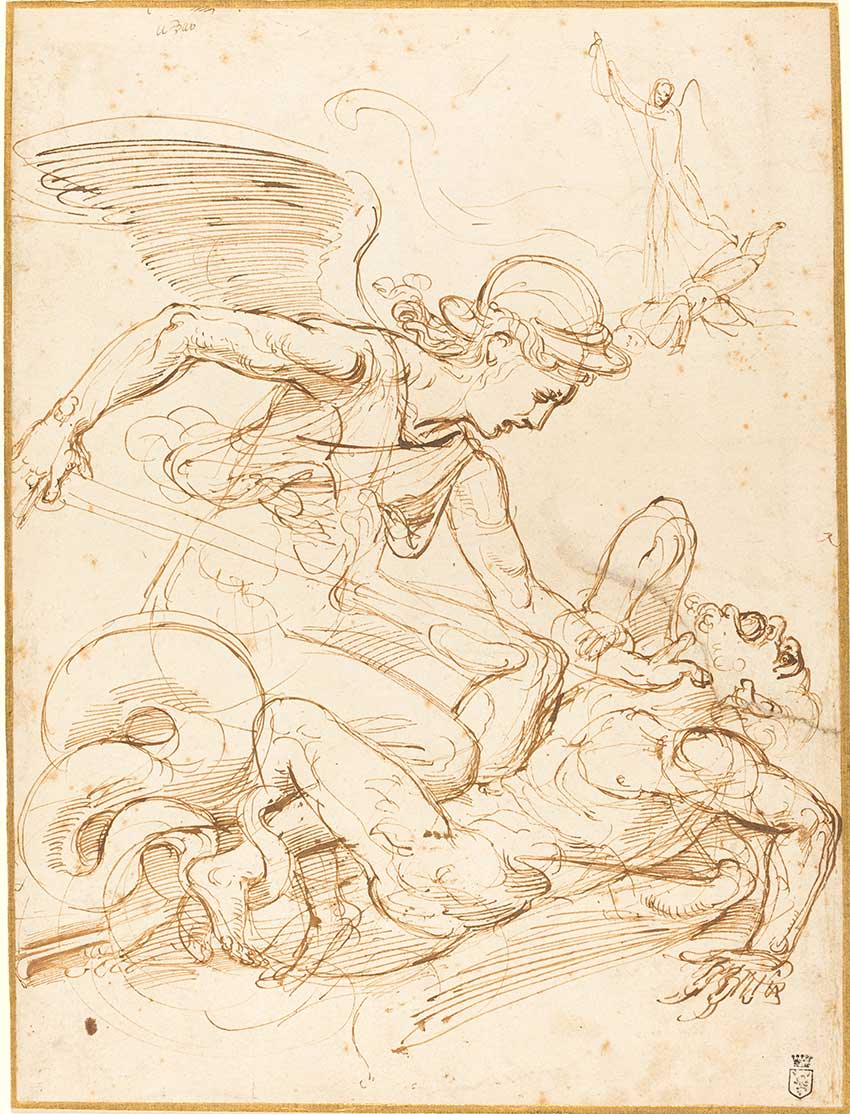
Giulio Romano, Saint Michael, c. 1527/1528, pen and brown ink, overall: 38.6 x 29 cm (15 3/16 x 11 7/16 in.) National Gallery of Art, Washington, Ailsa Mellon Bruce Fund
Saint Michael is usually depicted as a lofty figure trampling Satan, much as in the initial sketch at the upper right. In Giulio’s extraordinary, visceral conception, the two are locked in mortal combat that brings to mind classical relief sculpture. Like Raphael, Giulio preferred using pen for studies, only the scale is larger, the speed greater, and the rhythmic flourish exaggerated. Such extravagance and confidence are characteristic of Giulio’s art, which unsettled the visual equilibrium and expressive harmony of Raphael’s style. This drawing was probably a first idea for a painting but may have been conceived as an independent work.
GIULIO ROMANO
River God
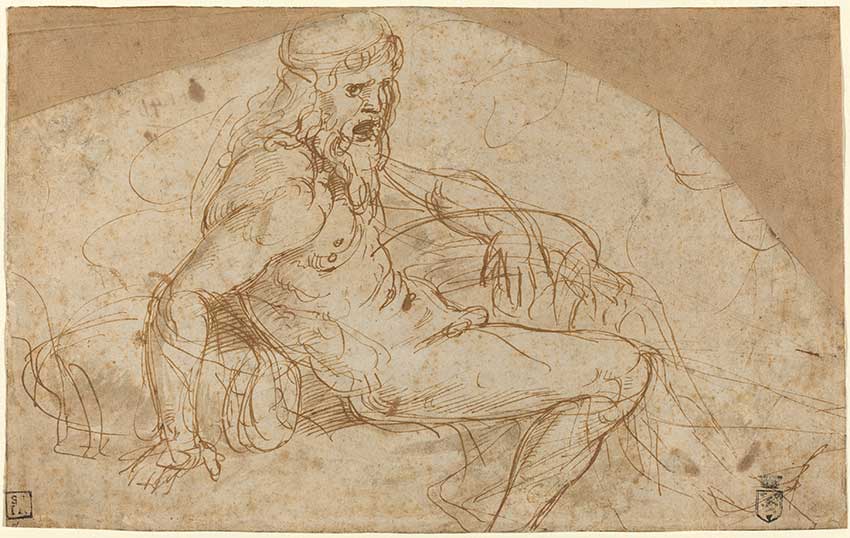 Giulio Romano, River God, c. 1528, pen and brown ink with brown wash on laid paper, overall (lunette): 17 x 27.5 cm (6 11/16 x 10 13/16 in.) overall: 86.3 cm (34 in.) National Gallery of Art, Washington, Richard King Mellon Charitable Trusts
Giulio Romano, River God, c. 1528, pen and brown ink with brown wash on laid paper, overall (lunette): 17 x 27.5 cm (6 11/16 x 10 13/16 in.) overall: 86.3 cm (34 in.) National Gallery of Art, Washington, Richard King Mellon Charitable Trusts
This drawing exemplifies Giulio Romano’s looser, more stylized interpretations of Raphael’s pen work. The drawing is a free rendering of ancient Roman statues of river gods enlivened by the artist’s vigorous calligraphy. It was a study for the figure of a river god that appears in the background of the artist’s fresco Wedding Banquet of Cupid and Psyche in the Palazzo Te outside Mantua, Italy.
Having achieved his own fame following the death of Raphael, Giulio was summoned to Mantua in 1525 to become court artist to the ruling Gonzaga family. His design and decoration of the Palazzo Te — their suburban residence — became the most important outpost of contemporary Roman style in northern Italy.
GIULIO ROMANO
The Sacrifice of a Goat to Jupiter
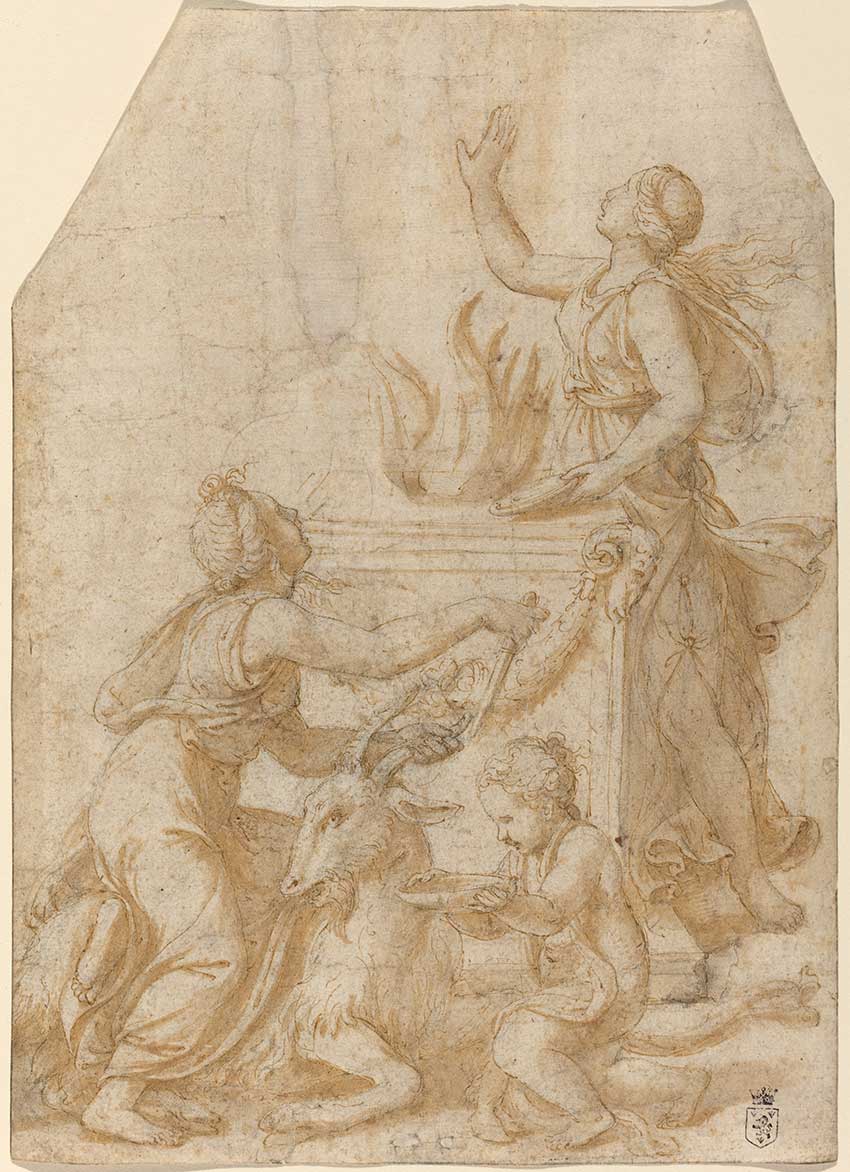 Giulio Romano, The Sacrifice of a Goat to Jupiter, c. 1527/1528, pen and brown ink with brown wash over black chalk on laid paper, overall: 28.9 x 20.9 cm (11 3/8 x 8 1/4 in.) support: 42.5 x 34.5 cm (16 3/4 x 13 9/16 in.) National Gallery of Art, Washington, Ailsa Mellon Bruce Fund
Giulio Romano, The Sacrifice of a Goat to Jupiter, c. 1527/1528, pen and brown ink with brown wash over black chalk on laid paper, overall: 28.9 x 20.9 cm (11 3/8 x 8 1/4 in.) support: 42.5 x 34.5 cm (16 3/4 x 13 9/16 in.) National Gallery of Art, Washington, Ailsa Mellon Bruce Fund
GIULIO ROMANO
The Four Elements
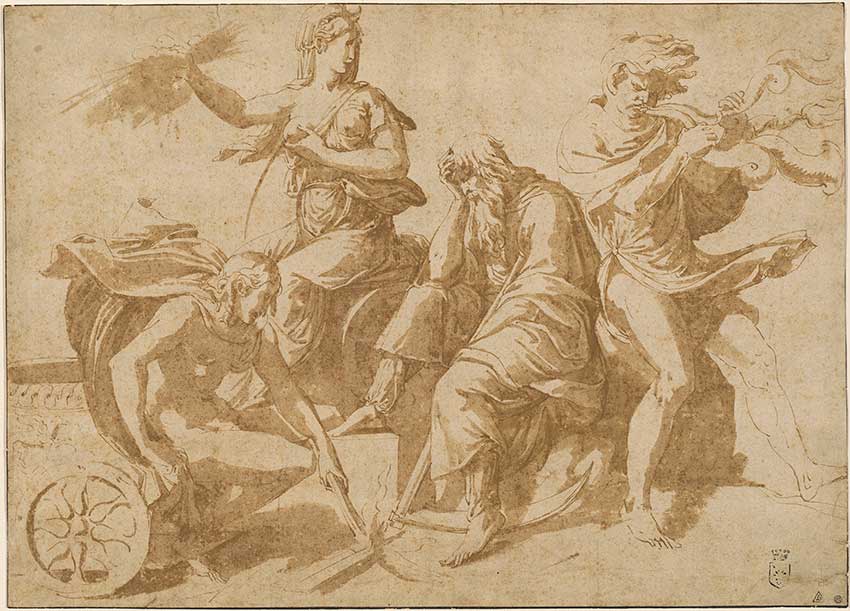
Giulio Romano, The Four Elements, c. 1530, pen and brown ink with brown wash on laid paper, overall: 24.2 x 33.7 cm (9 1/2 x 13 1/4 in.) National Gallery of Art, Washington, Wolfgang Ratjen Collection, Patrons’ Permanent Fund
PIERO BONACCORSI,
called PERINO DEL VAGA
Carmignano? (Florence), 1501 – Rome, 1547
Alexander Consecrating the Altars for the Twelve Olympian Gods
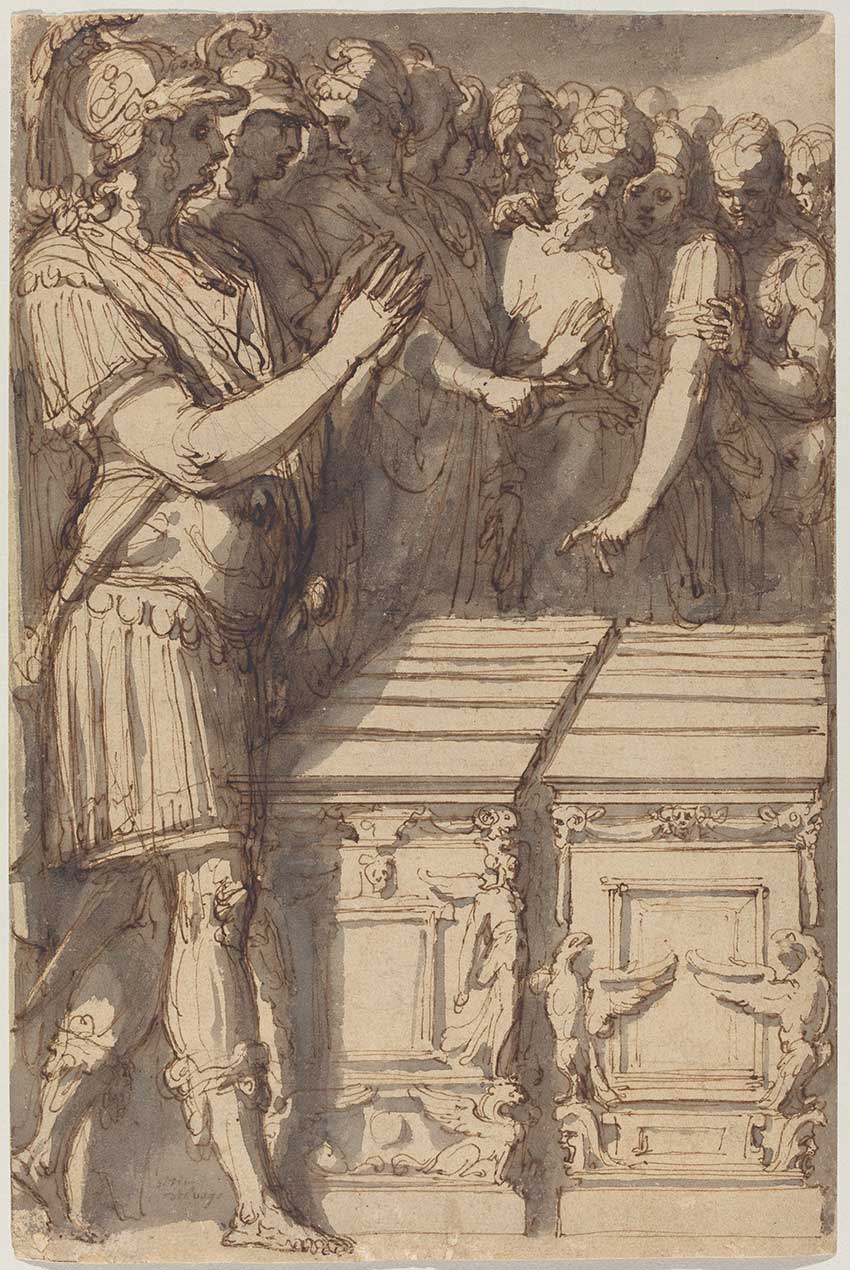
Perino del Vaga, Alexander Consecrating the Altars for the Twelve Olympian Gods, 1545/1547, pen and brown ink with gray wash over black chalk on laid paper; laid down, overall: 31.7 x 21 cm (12 1/2 x 8 1/4 in.) National Gallery of Art, Washington, Woodner Collection, Gift of Dian Woodner
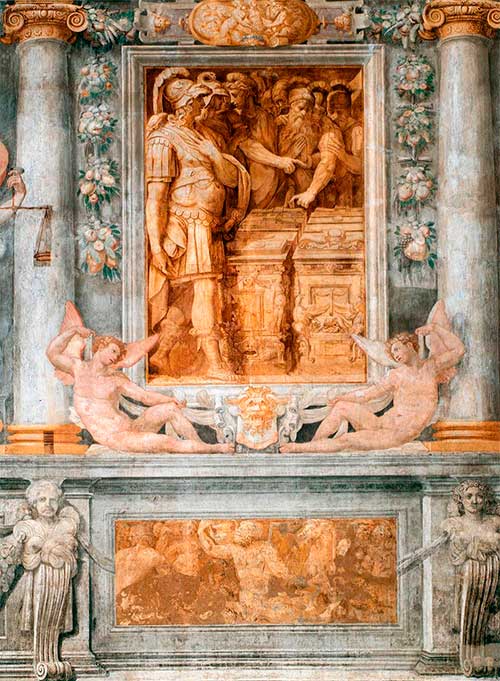 Perino del Vaga was the longest active of Raphael’s immediate followers. From 1538 he led a team of artists in decorating the apartments of Pope Paul III in the papal fortress, the Castel Sant’Angelo.
Perino del Vaga was the longest active of Raphael’s immediate followers. From 1538 he led a team of artists in decorating the apartments of Pope Paul III in the papal fortress, the Castel Sant’Angelo.
The great reception hall features six scenes from the life of Alexander the Great in monochrome, imitating bronze reliefs. This drawing prepared the scene of Alexander — the figure on the left — dedicating altars on the banks of the Hydaspes River (now the Jhelum River in northern India and eastern Pakistan) to thank the gods and celebrate his victories.
As in earlier drawings, Perino’s hand moved across the sheet rapidly, yet the figures are carefully weighted to evoke the bronze reliefs they are meant to suggest.
Perino del Vaga, Scenes from the Life of
Alexander the Great,1545 – 1547, fresco,
Sala Paolina, Castel Sant’Angelo
PERINO DEL VAGA
Altarpiece of the Madonna and Child
with Saints, in Its Architectural Setting
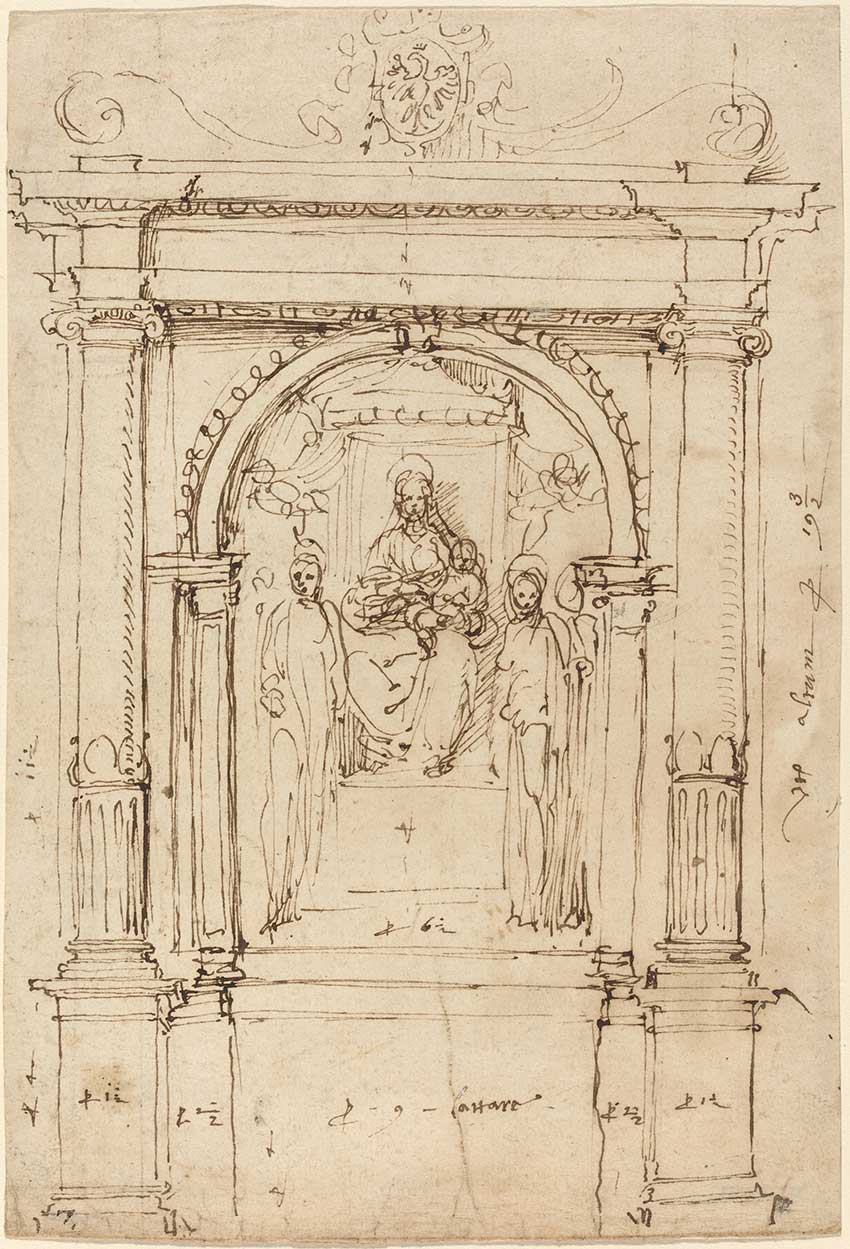
Perino del Vaga, Altarpiece of the Madonna and Child with Saints, in Its Architectural Setting, 1528/1537, pen and brown ink on laid paper, overall: 23.6 x 16.1 cm (9 5/16 x 6 5/16 in.) National Gallery of Art, Washington, Gift of The Circle of the National Gallery of Art
PERINO DEL VAGA
Figure Studies [recto]
![Perino-del-Vaga_Figure-Studies-[recto],-c](http://patrons.org.es/wp-content/uploads/2020/03/Perino-del-Vaga_Figure-Studies-recto-c.jpg)
Perino del Vaga, Figure Studies [recto], c. 1530/1540, pen and brown ink on laid paper, overall: 19.2 x 27.4 cm (7 9/16 x 10 13/16 in.) National Gallery of Art, Washington, Pepita Milmore Memorial Fund
Building upon Raphael’s manner of pen drawing, Perino del Vaga would often fill a sheet with rapid studies to explore variations in posture and successive stages of movement. His figures seem delicately poised and light, even when their postures are complicated or their movements sudden. On both sides of this sheet the figures are engaged in various actions related to battle. Distributed evenly across the page without a central focus, they are a tapestry of form. The verso includes some sort of an inventory in Perino’s hand, underscoring the working nature of the drawing.
PERINO DEL VAGA
Figure Studies [verso]
![Perino-del-Vaga_Figure-Studies-[verso],-c](http://patrons.org.es/wp-content/uploads/2020/03/Perino-del-Vaga_Figure-Studies-verso-c.jpg)
Perino del Vaga, Figure Studies [verso], c. 1530/1540, pen and brown ink on laid paper, overall: 19.2 x 27.4 cm (7 9/16 x 10 13/16 in.) National Gallery of Art, Washington, Pepita Milmore Memorial Fund
POLIDORO CALDARA,
called POLIDORO DA CARAVAGGIO
Caravaggio (Bergamo), c. 1499 – Messina, 1543
Fleeing Barbarian
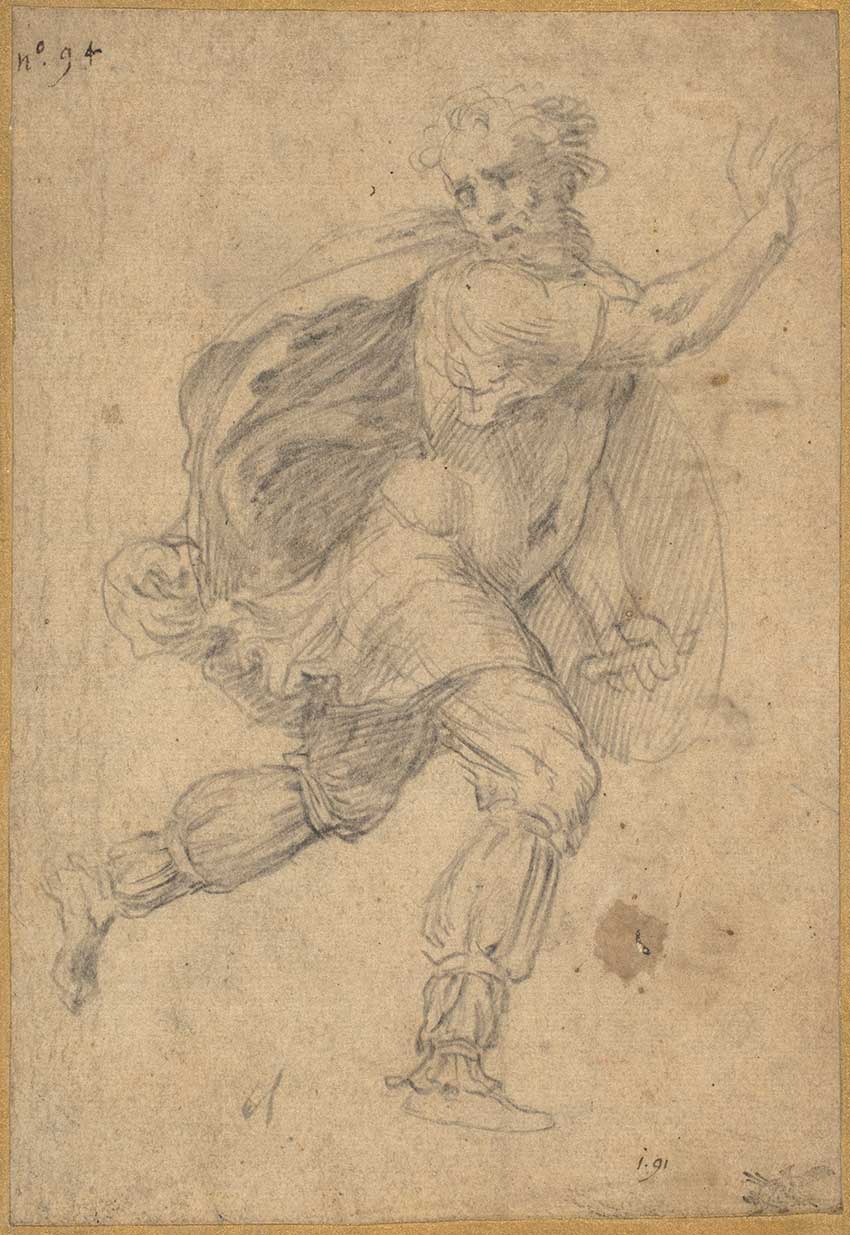
Polidoro da Caravaggio, Fleeing Barbarian, early 1520s, black chalk on laid paper, sheet: 17.8 x 12.1 cm (7 x 4 3/4 in.) mount: 27.2 x 21.2 cm (10 11/16 x 8 3/8 in.) National Gallery of Art, Washington, Joseph F. McCrindle Collection
POLIDORO DA CARAVAGGIO
A Deathbed Scene [recto]
![Polidoro-da-Caravaggio_A-Deathbed-Scene-[recto],-c.-1521-1522_5366-014](http://patrons.org.es/wp-content/uploads/2020/03/Polidoro-da-Caravaggio_A-Deathbed-Scene-recto-c.-1521-1522_5366-014.jpg)
Polidoro da Caravaggio, A Deathbed Scene [recto], c. 1521/1522, red chalk on laid paper, overall: 21 x 29 cm (8 1/4 x 11 7/16 in.) National Gallery of Art, Washington, Gift of David E. Rust, in Honor of the 50th Anniversary of the National Gallery of Art.
Polidoro da Caravaggio, who came to Rome from a small town in Lombardy, was the most eccentric of Raphael’s followers. His style resists the idealized beauty and calculation of the master’s work. The distorted perspective, agitated movements, and strained postures in the deathbed scene, as well as the intense feeling they convey, are typical of Polidoro. The figure of a woman on the reverse may be a more detailed study for the same composition. This was a preparatory drawing for part of a fresco frieze on the interior of a Roman palace.
POLIDORO DA CARAVAGGIO
A Deathbed Scene [recto]
![Polidoro-da-Caravaggio_woman-Seated-with-a-Piece-of-Cloth-[verso],-c](http://patrons.org.es/wp-content/uploads/2020/03/Polidoro-da-Caravaggio_woman-Seated-with-a-Piece-of-Cloth-verso-c.jpg)
Polidoro da Caravaggio, Woman Seated with a Piece of Cloth [verso], c. 1521/1522, red chalk on laid paper, overall: 21 x 29 cm (8 1/4 x 11 7/16 in.) National Gallery of Art, Washington, Gift of David E. Rust, in Honor of the 50th Anniversary of the National Gallery of Art
Raphael was the first artist to exploit
the possibilities of printmaking
Rafael exploited the possibilitiess of printmaking to disseminate his inventions, enhance his reputation, and generate income. This practice caused his art to become a universal European language. Raphael’s prints demonstrated to an international audience his magisterial command of complex, multifigure compositions and his modern style rooted in the study of ancient art.
This exhibition includes 10 engravings by one of the earliest interpreters of his designs, Marcantonio Raimondi (c. 1480–c. 1534), Agostino dei Musi (c. 1490–1536) and Marco Dente (c. 1493–1527), and Ugo da Carpi
MARCANTONIO RAIMONDI
Argini? (Bologna), c. 1480 – Bologna?, c. 1534
after RAPHAEL
The Lamentation of the Virgin
engraving
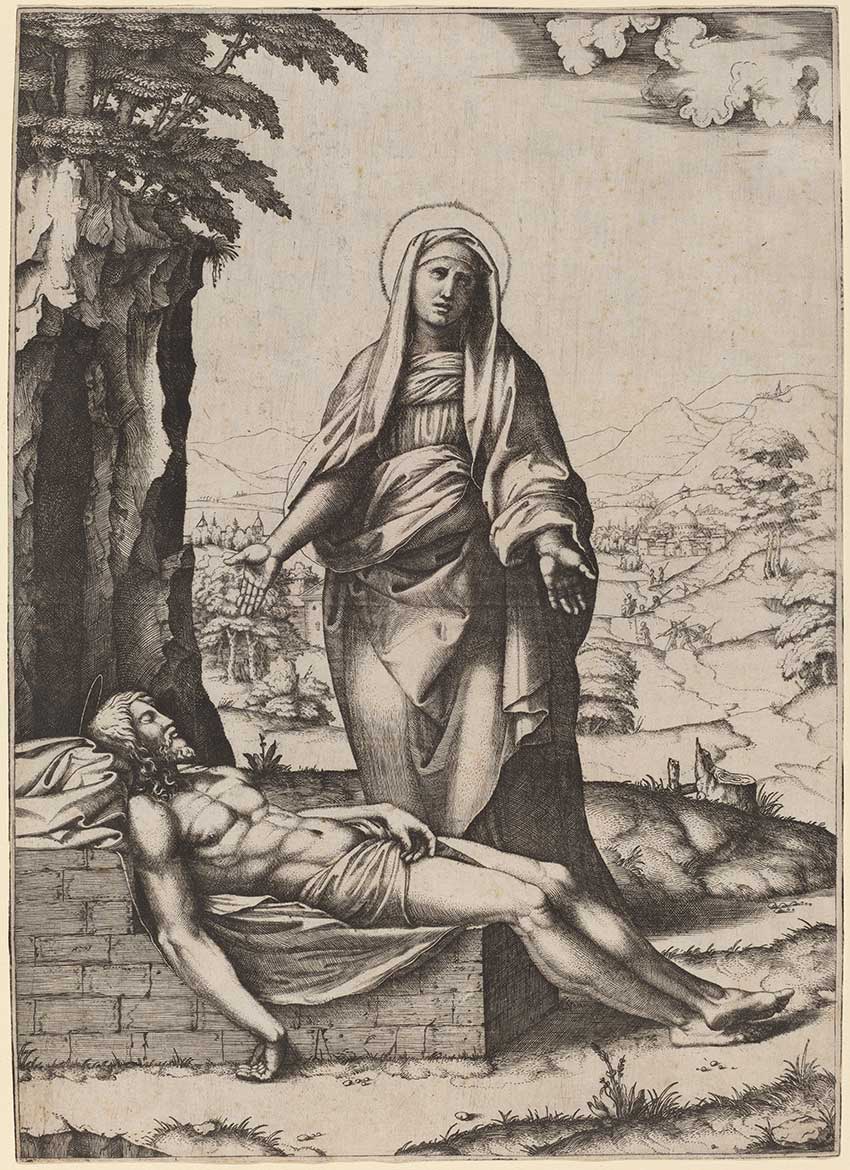
Marcantonio Raimondi after Raphael, The Lamentation of the Virgin, 1510, engraving, sheet (trimmed to plate mark): 32.1 x 23.3 cm (12 5/8 x 9 3/16 in.) National Gallery of Art, Washington, Rosenwald Collection
MARCANTONIO RAIMONDI
after Raphael
The Massacre of the Innocents
engraving
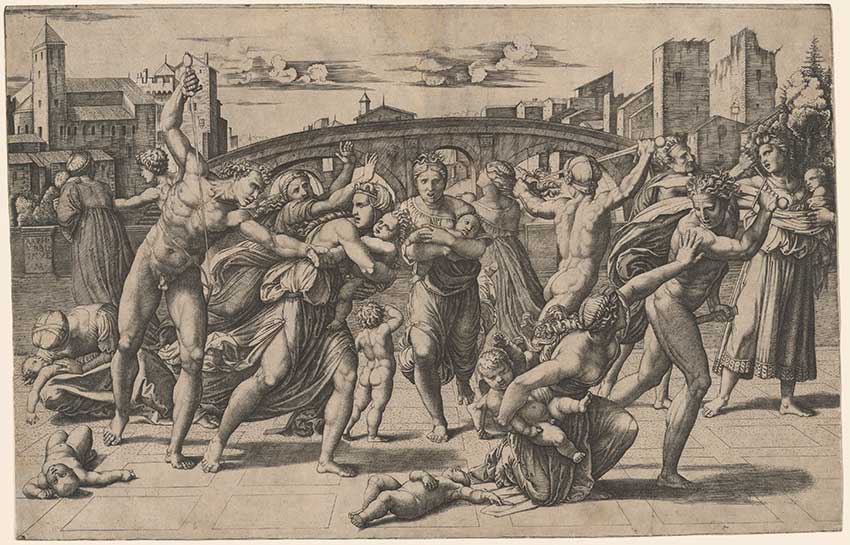
Marcantonio Raimondi after Raphael, The Massacre of the Innocents, c. 1511, engraving, sheet (trimmed within plate mark): 28.1 x 43.4 cm (11 1/16 x 17 1/16 in.) National Gallery of Art, Washington, Print Purchase Fund (Rosenwald Collection)
The Massacre of the Innocents is probably Raphael’s most famous design for an engraving. It epitomizes the artist’s classical style in the perfection of individual forms, the unified expression across the figures, and the orchestration of the composition into a coherent whole. Arriving in Rome around 1510, Marcantonio Raimondi made hundreds of engravings that interpret Raphael’s designs. Although the exact nature of their collaboration is not known, it was certainly the first time an engraver dedicated himself to the interpretation of an artist’s designs.
Raphael’s immediate influence and fame are indebted to Raimondi’s production, which significantly increased the circulation and visibility of Raphael’s work. Such reproductive printmaking would remain the means of disseminating images of works of art until the rise of commercial photography four-and-a-half centuries later.
MARCANTONIO RAIMONDI
after Raphael
Apollo on Parnassus
engraving
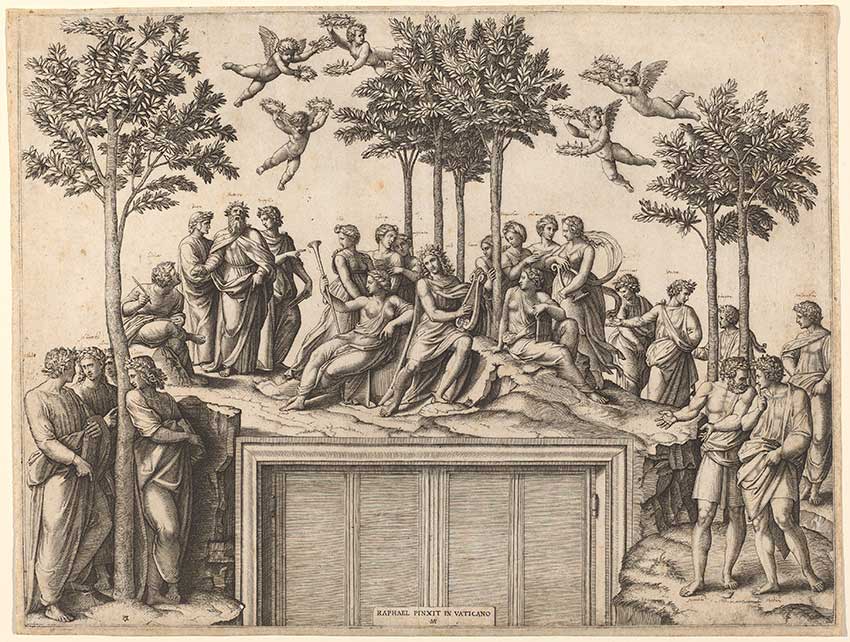
Marcantonio Raimondi after Raphael, Apollo on Parnassus, 1515/1520, engraving, plate: 35.8 x 47.6 cm (14 1/8 x 18 3/4 in.) sheet: 36.8 x 48.4 cm (14 1/2 x 19 1/16 in.) National Gallery of Art, Washington, Ailsa Mellon Bruce Fund
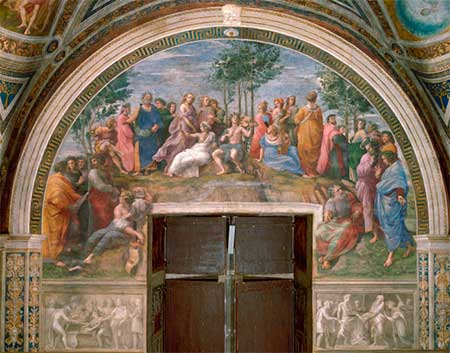 One of the four principal frescoes in the Vatican’s Stanza della Segnatura. The frescoes Parnassus shows Apollo surrounded by the Muses and famous ancient and contemporary poets.
One of the four principal frescoes in the Vatican’s Stanza della Segnatura. The frescoes Parnassus shows Apollo surrounded by the Muses and famous ancient and contemporary poets.
Raimondi’s engraving, inscribed “Raphael Painted in the Vatican,” differs from the fresco in the more uniform distribution and simpler postures of the figures.
This impression of the print is notable for its great clarity and the annotations that identify each figure.
Image: Raphael, Parnassus, Stanza della Seganatura, Stanze di Raffaello, Vatican Palace.
Photo: Scala/Art Resource, NY
MARCANTONIO RAIMONDI
after Raphael
Il Morbetto (The Plague)
engraving
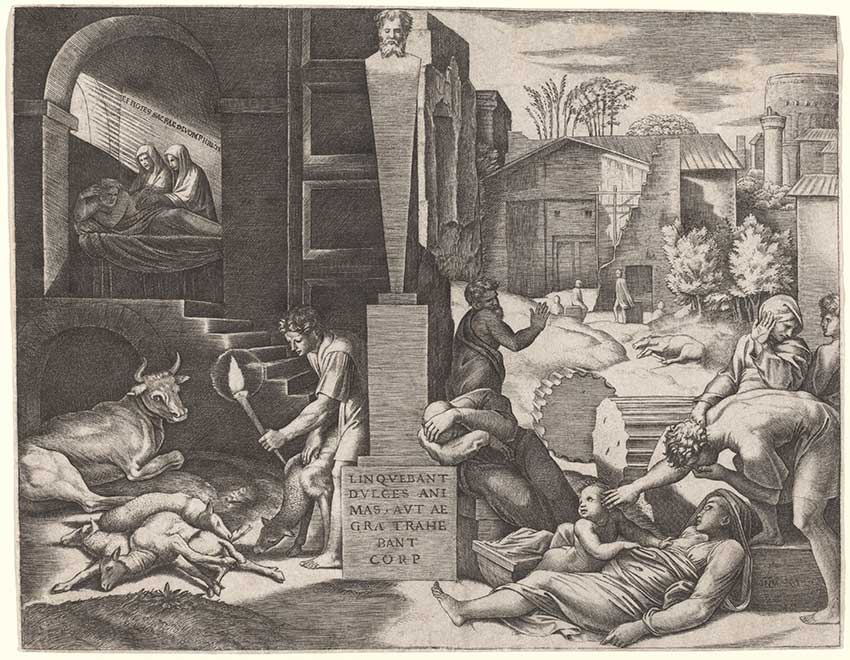 Marcantonio Raimondi after Raphael, Il Morbetto (The Plague), c. 1512/1513, engraving, sheet (trimmed to plate mark): 19.5 x 25.2 cm (7 11/16 x 9 15/16 in.) National Gallery of Art, Washington, Gift of W.G. Russell Allen
Marcantonio Raimondi after Raphael, Il Morbetto (The Plague), c. 1512/1513, engraving, sheet (trimmed to plate mark): 19.5 x 25.2 cm (7 11/16 x 9 15/16 in.) National Gallery of Art, Washington, Gift of W.G. Russell Allen
Virgil’s Aeneid, the epic poem about the foundation of Rome, describes the plague that struck the Trojans in Phrygia — modern Turkey — before Aeneas led them to Italy. In this design Raphael depicted the macabre scene of dying humans and animals and quoted from the Latin poem: “They relinquished sweet life and dragged their sick bodies.” He turned the scene into a demonstration of compositional daring with figural invention and classical references, such as the stone pillar with the sculpted head—an ancient boundary marker. Raimondi’s line work is especially fine and dense in this engraving, generating a subtle range of tones.
MARCANTONIO RAIMONDI
after Raphael
Saint Cecilia
engraving
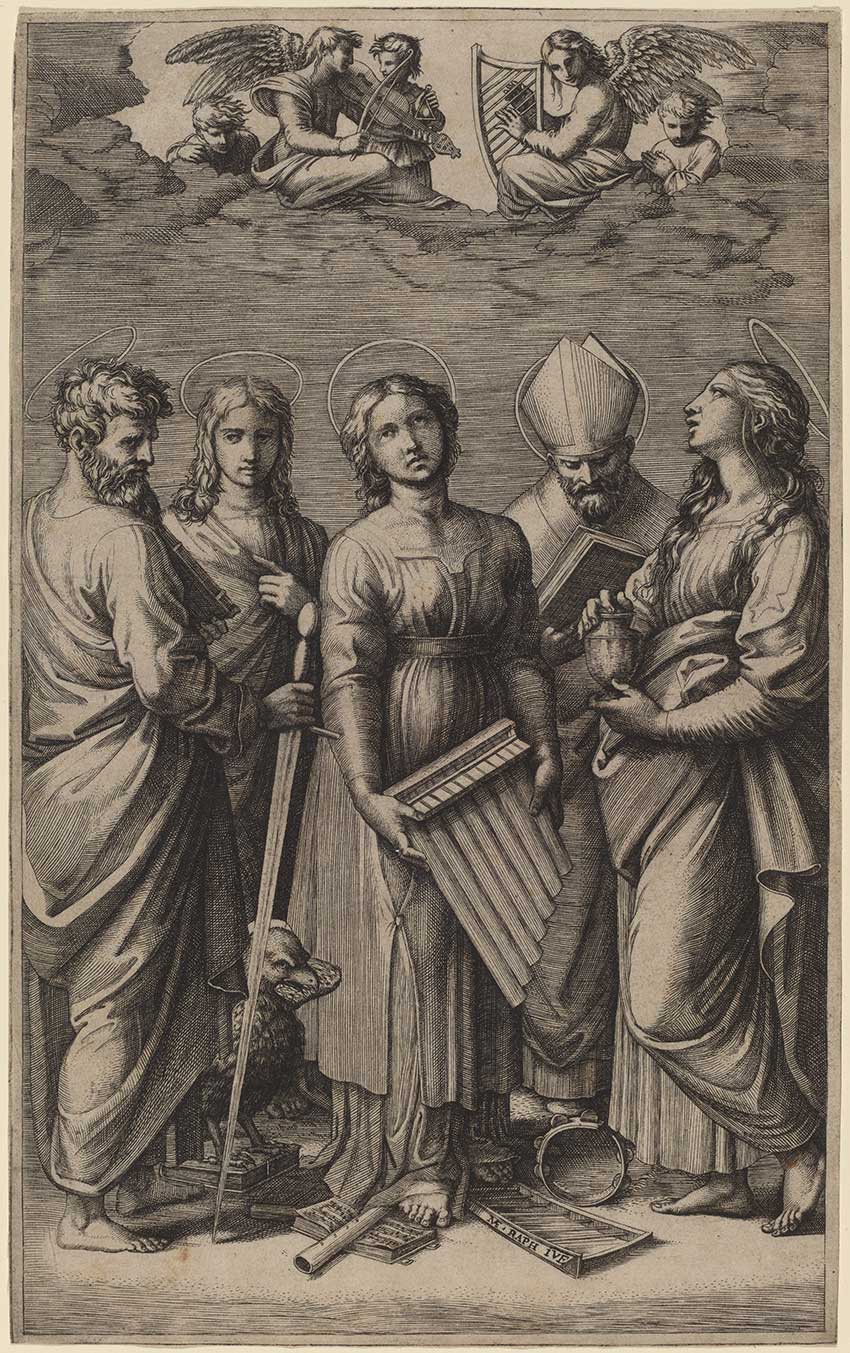
Marcantonio Raimondi after Raphael, Saint Cecilia, c. 1515/1516, engraving, plate: 26 x 16.2 cm (10 1/4 x 6 3/8 in.) National Gallery of Art, Washinngton, Rosenwald Collection.
MARCANTONIO RAIMONDI
after Raphael
The Holy Family with the Young Saint John the Baptist
(The Madonna of the Long Thigh)
engraving
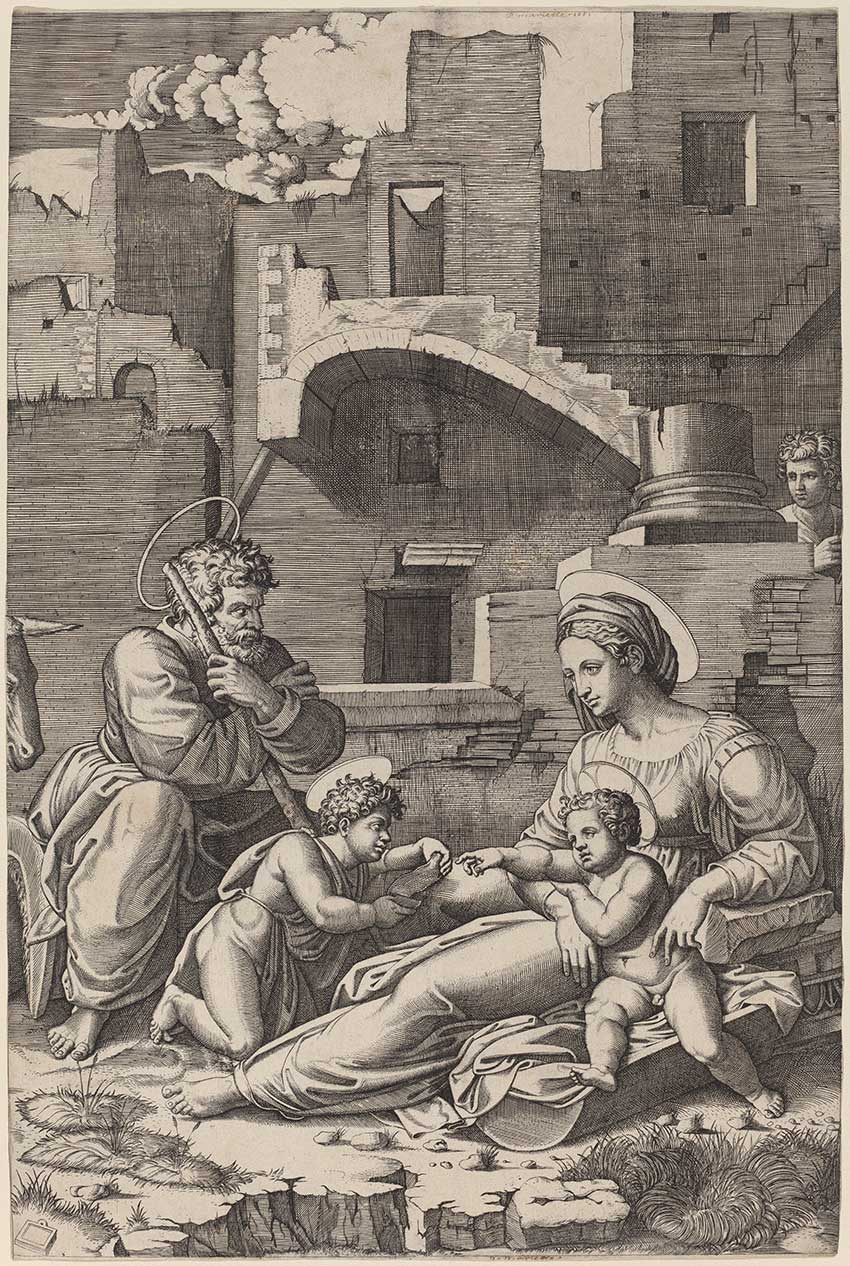
Marcantonio Raimondi after Raphael, The Holy Family with the Young Saint John the Baptist (The Madonna of the Long Thigh), c.1518/1519, engraving, sheet (trimmed to plate mark): 41.1 x 27.5 cm (16 3/16 x 10 13/16 in.) National Gallery of Art, Washinngton, Rosenwald Collection
The traditional name of this engraving, one of Raimondi’s most admired, refers to the unusual extension and prominence of the Virgin’s thigh. The background architecture is similarly unconventional in both its proportion and stylized geometry. The increasing emphasis on artifice over natural appearance is characteristic of Raphael’s latest style. The creation of the print was seamlessly collaborative: Raphael was responsible for the basic design, Giulio Romano for creating the painting based on that design, and Raimondi for its translation into engraving.
AGOSTINO DEI MUSI,
called AGOSTINO VENEZIANO
Venice, c. 1490 – Rome?, c. 1536
after GIULIO ROMANO
engraving
The Battle with the Cutlass
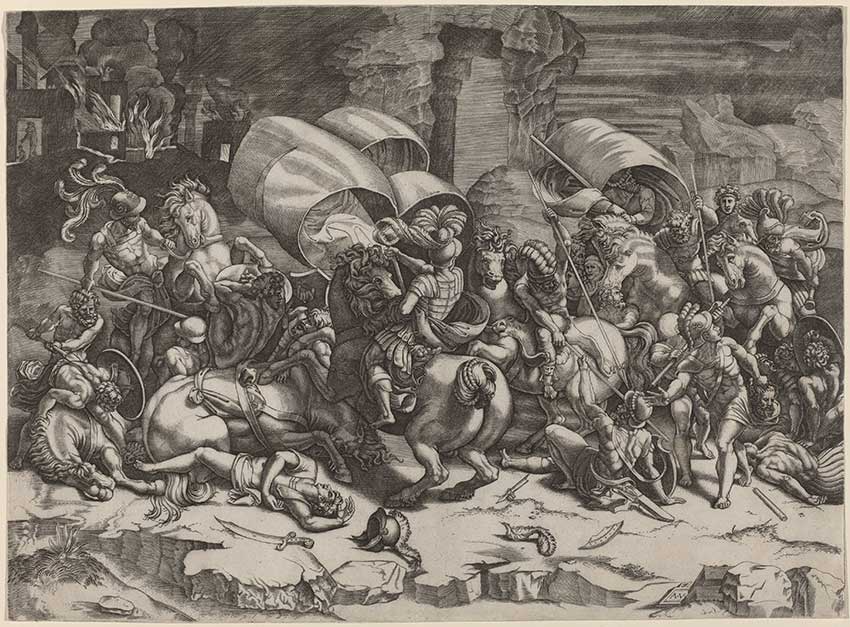 Agostino dei Musi, after Giulio Romano, The Battle with the Cutlass, c. 1531, engraving on laid paper, sheet: 33.7 x 46.2 cm (13 1/4 x 18 3/16 in.) National Gallery of Art, Washington, Ailsa Mellon Bruce Fund
Agostino dei Musi, after Giulio Romano, The Battle with the Cutlass, c. 1531, engraving on laid paper, sheet: 33.7 x 46.2 cm (13 1/4 x 18 3/16 in.) National Gallery of Art, Washington, Ailsa Mellon Bruce Fund
MARCO DENTE,
called MARCO DA RAVENNA
Ravenna, c. 1493 – Rome, 1527
after RAPHAEL
The Virgin with a Fish
engraving
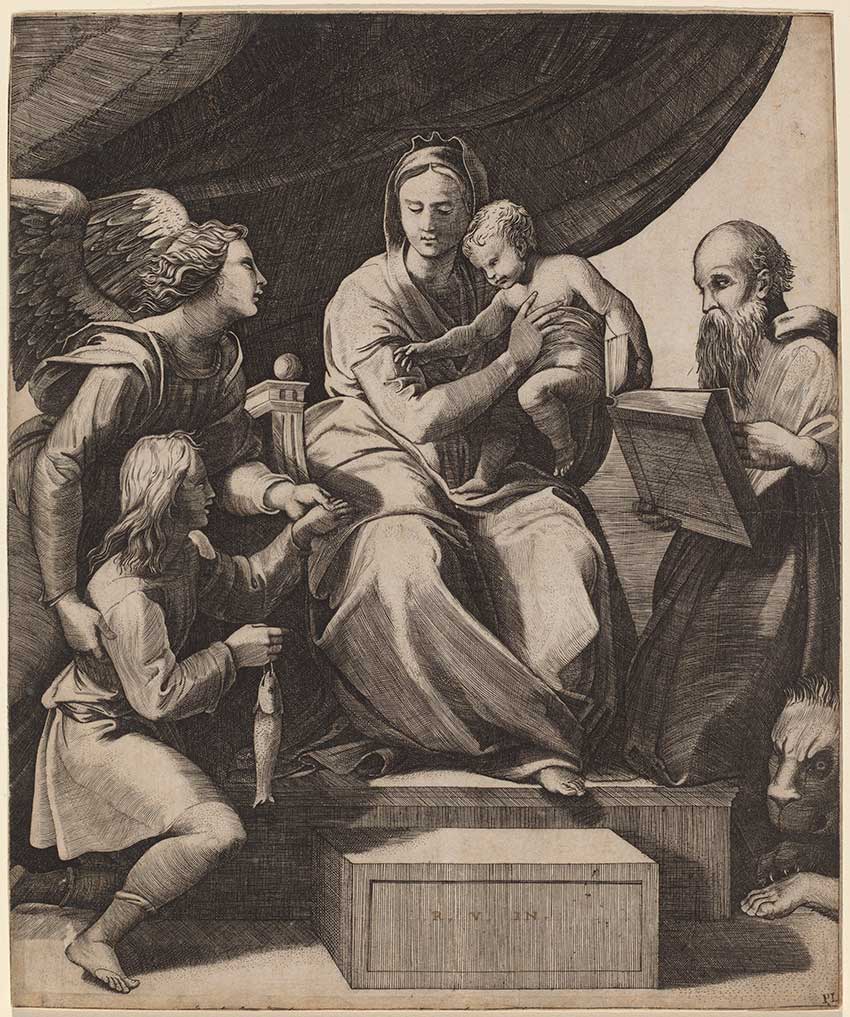 Marco Dente after Raphael, The Virgin with a Fish, c. 1515/1520, engraving, sheet: 26.4 x 22 cm (10 3/8 x 11/16 in.) National Gallery of Art, Washington, Ailsa Mellon Bruce Fund.
Marco Dente after Raphael, The Virgin with a Fish, c. 1515/1520, engraving, sheet: 26.4 x 22 cm (10 3/8 x 11/16 in.) National Gallery of Art, Washington, Ailsa Mellon Bruce Fund.
UGO DA CARPI
Carpi (Modena), c. 1480 – Bologna, 1532
after RAPHAEL
David Slaying Goliath
chiaroscuro woodcut
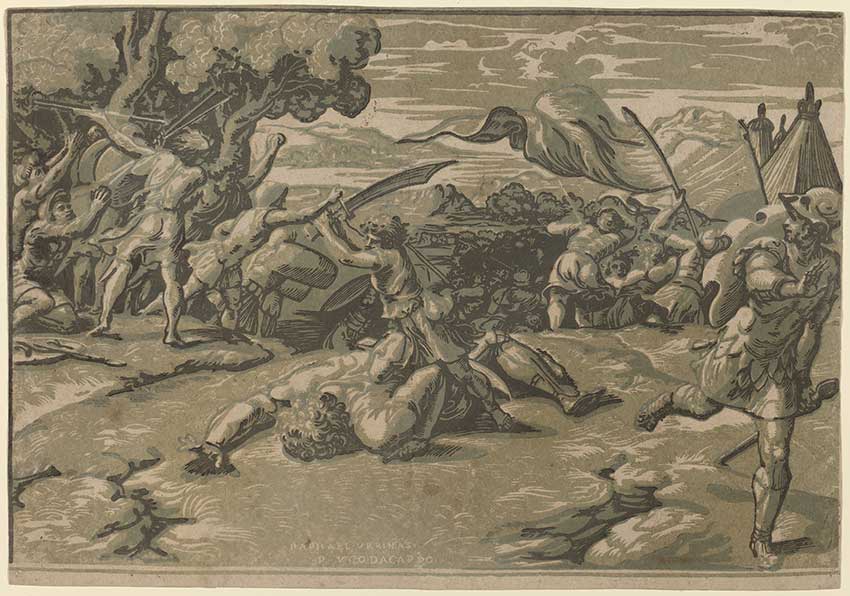 Ugo da Carpi after Raphael, David Slaying Goliath, c. 1520, chiaroscuro woodcut (3 blocks) sheet: 27.1 x 38.8 cm (10 11/16 x 15 1/4 in.) National Gallery of Art, Washington, Gift of David Keppel
Ugo da Carpi after Raphael, David Slaying Goliath, c. 1520, chiaroscuro woodcut (3 blocks) sheet: 27.1 x 38.8 cm (10 11/16 x 15 1/4 in.) National Gallery of Art, Washington, Gift of David Keppel
MASTER OF THE DIE
active in Rome, c. 1532
after RAPHAEL
Apollo and Marsyas
engraving
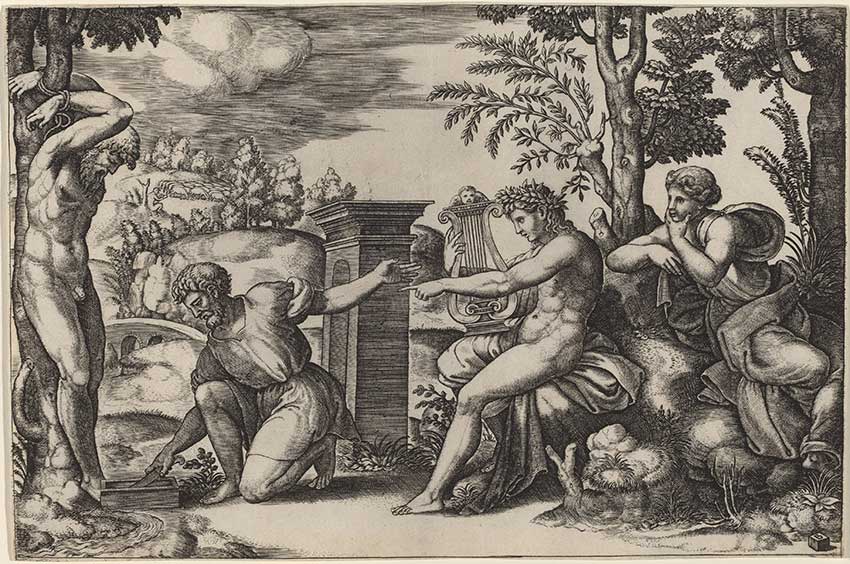 Master of the Die after Raphael, Apollo and Marsyas, 1530s, engraving, sheet (trimmed to plate mark): 18.7 x 28.3 cm (7 3/8 x 11 1/8 in.) National Gallery of Art, Washington, Ailsa Mellon Bruce Fund
Master of the Die after Raphael, Apollo and Marsyas, 1530s, engraving, sheet (trimmed to plate mark): 18.7 x 28.3 cm (7 3/8 x 11 1/8 in.) National Gallery of Art, Washington, Ailsa Mellon Bruce Fund
EXHIBITION ORGANIZATION
The exhibition is organized by the National Gallery of Art, Washington
EXHIBITION CURATOR
The exhibition is curated by Jonathan Bober, Andrew W. Mellon Senior Curator
of Prints and Drawings, National Gallery of Art
–
RAPHAEL (1483–1520)
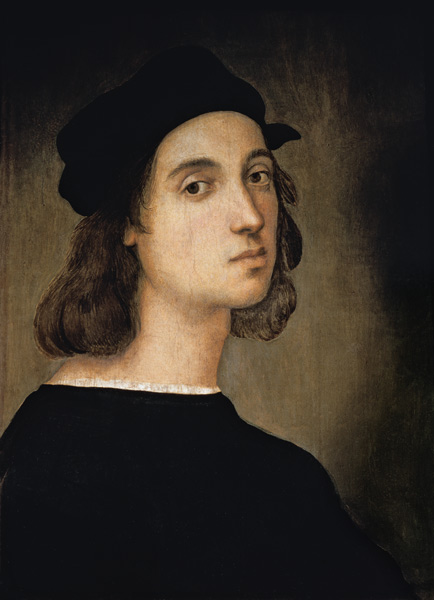 Raffaelo di Giovanni Santi, known as Raphael, was a younger contemporary of Leonardo da Vinci and Michelangelo, all of whom epitomize the High Renaissance in Italy. It is thought that Raphael’s early training was with his father, who was a painter at the court of Urbino. He joined the workshop of Pietro Perugino sometime after the death of his father, when Raphael was 11 years old.
Raffaelo di Giovanni Santi, known as Raphael, was a younger contemporary of Leonardo da Vinci and Michelangelo, all of whom epitomize the High Renaissance in Italy. It is thought that Raphael’s early training was with his father, who was a painter at the court of Urbino. He joined the workshop of Pietro Perugino sometime after the death of his father, when Raphael was 11 years old.
Late in 1504, Raphael moved to Florence, drawn by Leonardo’s softly shadowed forms, natural figure groupings, and simplified settings. In 1508 the pope summoned Raphael to Rome, where he was influenced by the idealized classical art of the city’s ancient past. He also responded to the more energetic and physical style of Michelangelo, whose works he had already begun to study in Florence.
Raphael remained in Rome for the last 12 years of his life, preparing monumental frescoes for the papal chambers, designing tapestries for the Sistine Chapel, and painting mythological scenes. He was also the city’s leading portraitist, creating penetrating images that engage viewer and sitter with a new intensity for the time. When he died at age 37, the pope ordered that Raphael, who had been keeper of antiquities, be buried in the Pantheon. IMAGE: Raphael self portrait
Raphael 500
Several major exhibitions have been organized to mark the 500th anniversary of Raphael’s death. The National Gallery of Art offers its own homage through this exhibition and the display of its paintings by Raphael—the largest and most important group outside of Europe.
The Galleria Nazionale delle Marche inaugurates the year’s tribute with an exhibition in his hometown of Urbino (Raphael and His Friends of Urbino, October 3, 2019–January 19, 2020).
Scuderie del Quirinale, Rome (Raffaello, March 5–June 2, 2020),
National Gallery, London (The Credit Suisse Exhibition: Raphael, October 3, 2020–January 24, 2021).
The Gallery will loan
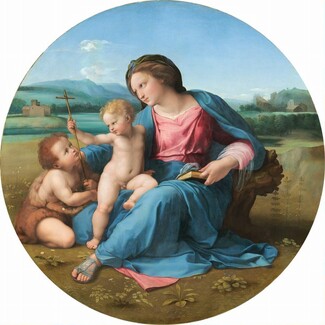
The Alba Madonna (c. 1510)
to the Scuderie del Quirinale, Rome
as well as Bindo Altoviti (c. 1515)
oil on panel transferred to canvas
overall (diameter): 94.5 cm (37 3/16 in.)
framed (diameter x depth): 140.34 × 15.88 cm
(55 1/4 × 6 1/4 in.)
Andrew W. Mellon Collection
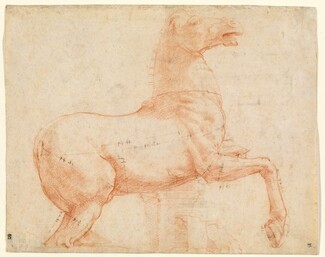
A Marble Horse on the Quirinal Hill (c. 1513)
to the National Gallery, London, in honor of this anniversary.
Red chalk and pen and brown ink, with stylus underdrawing
and traces of leadpoint on laid paper,
overall: 21.9 x 27.4 cm (8 5/8 x 10 13/16 in.)
Woodner Collection
At the Veneranda Biblioteca Ambrosiana, Milan, a newly conserved preparatory cartoon (c. 1508) for the Vatican fresco School of Athens (1509) is on view. The Victoria and Albert Museum, London, will be highlighting their set of seven full-scale cartoons by Raphael for tapestries.
NATIONAL GALLERY OF ART
Constitution Ave & 6th St, Washington, DC 20565, USA
Telephone: (202) 737-4215
https://www.nga.gov/